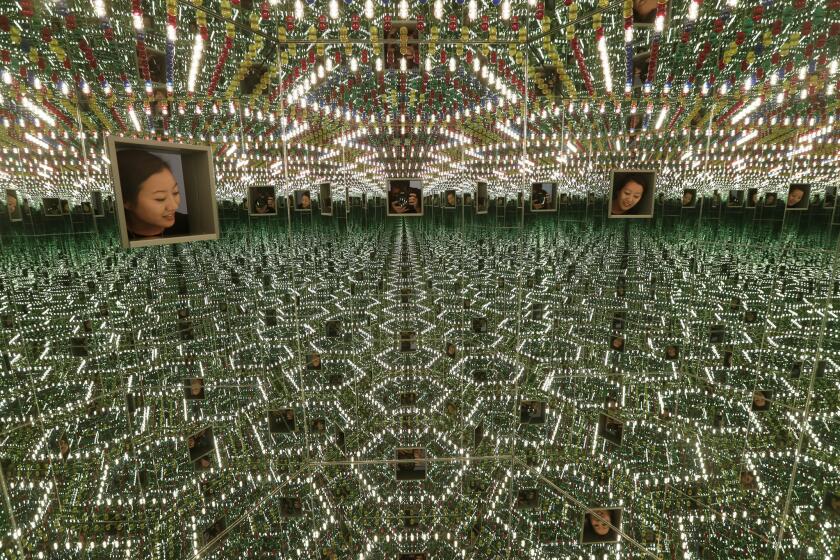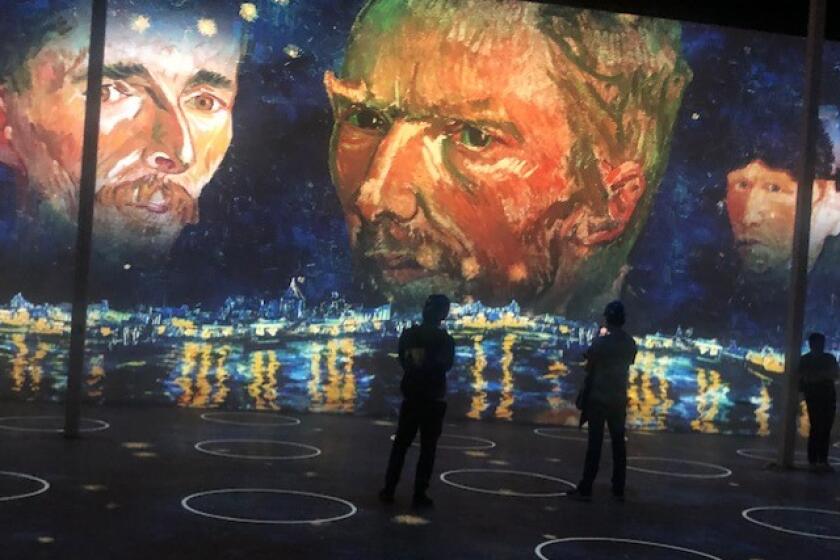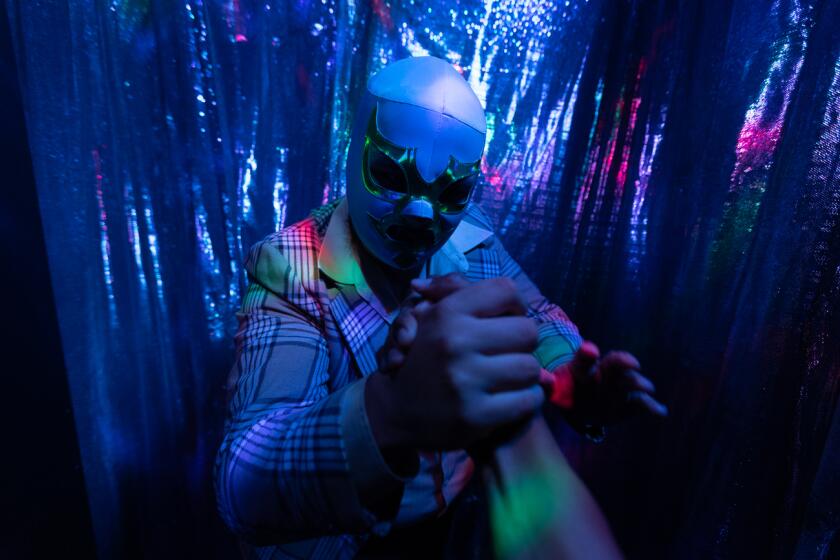A psychedelic mixtape by Chris Holmes will christen immersive tech company Cosm’s new L.A. outpost
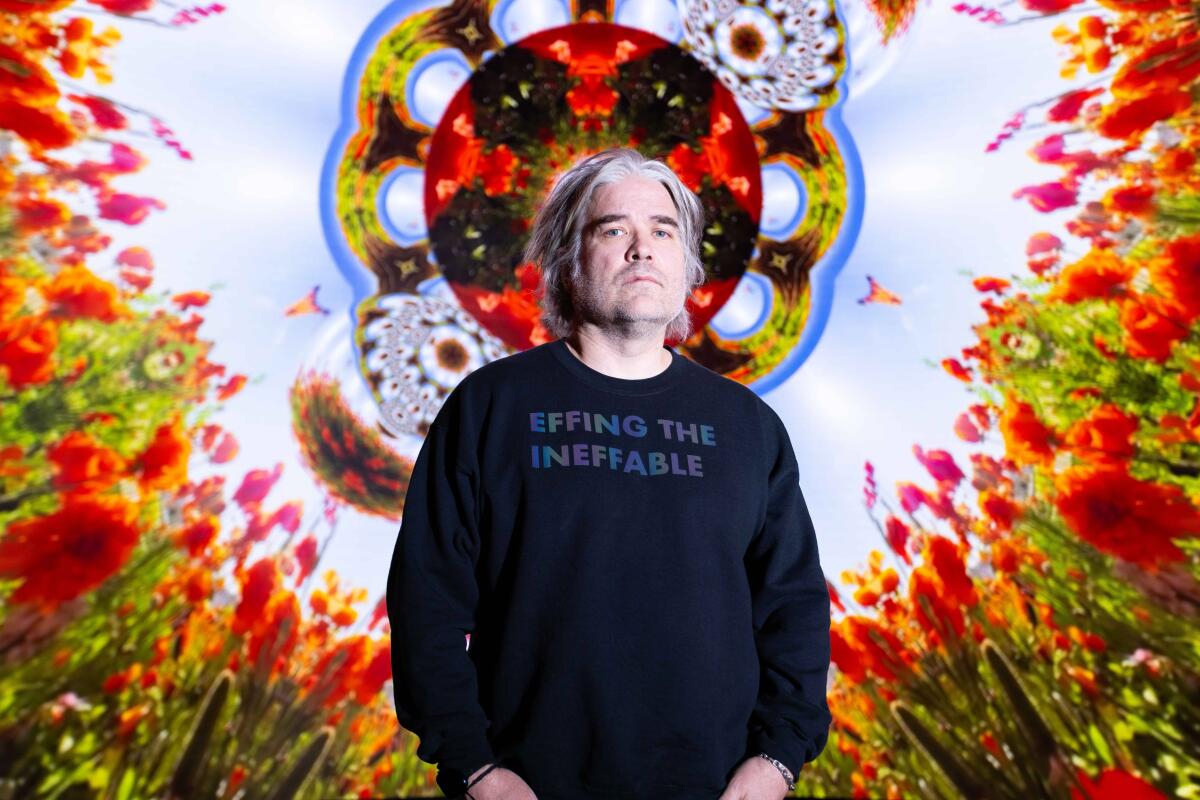
- Share via
The forthcoming immersive experience “The Journey Within,” debuting in Los Angeles in the spring, puts a new spin on “turn on, tune in, drop out.” The show is not unlike being completely enveloped within a kaleidoscope made of luminous light, vibrant indigo and violet, while a remixed version of David Bowie’s “Ziggy Stardust” serenades viewers into a trance-like state.
Immersive technology company Cosm, along with “tech alchemist” and DJ Chris Holmes, will unveil “The Journey Within” at Cosm venues in 2024. Notably, that includes the company’s brand-new, 87-foot diameter 12K LED dome opening in L.A. sometime in the spring. Located in Hollywood Park’s retail district, the forthcoming space uses domed and compound curved LED technology, which creates a hemispheric screen, rather than a rectangular one. The 65,000-square-foot facility will be able to host up to 1,700 guests, who can enjoy immersive media along with craft cocktails and dining options.
One of Cosm’s existing venues, used for showcases and private events, currently occupies Salt Lake City’s Experience Center; it boasts a 5,000-square-foot LED dome display broadcasting major sporting events in 8K resolution. Cosm will also open a dome in Dallas later next year.
Chris Holmes marches to his own extraterrestrial drummer
Cosm and Holmes dub the experience of viewing “The Journey Within” inside one of these domes as a form of “shared reality.” Neil Carty, vice president of Cosm Studio and Labs, describes shared reality as the connection that people feel when sharing a powerful experience. “That’s what shared reality is all about, experiencing something bigger than yourself,” Carty tells The Times.
Holmes, a DJ and musician who’s toured with Paul McCartney, said the idea for this piece came to him during the pandemic. “At a time when all the screens in our life are triggering ego, fear and worry, the idea is to use screens to help connect us to wonder, joy and fascination,” Holmes says. As a DJ, he started to toy with the idea of not just remixing music, but remixing light.
To create the visuals, which blend with the remixed music of David Bowie, Radiohead, the Flaming Lips, Matthew Dear and others, Holmes used a laser cutter. With it, he created LED kaleidoscopes and laser sculptures. He then made video recordings of the world’s natural wonders, ranging from the glaciers of Antarctica to the blue lakes of northern Minnesota, where Holmes’ wife has a cabin.
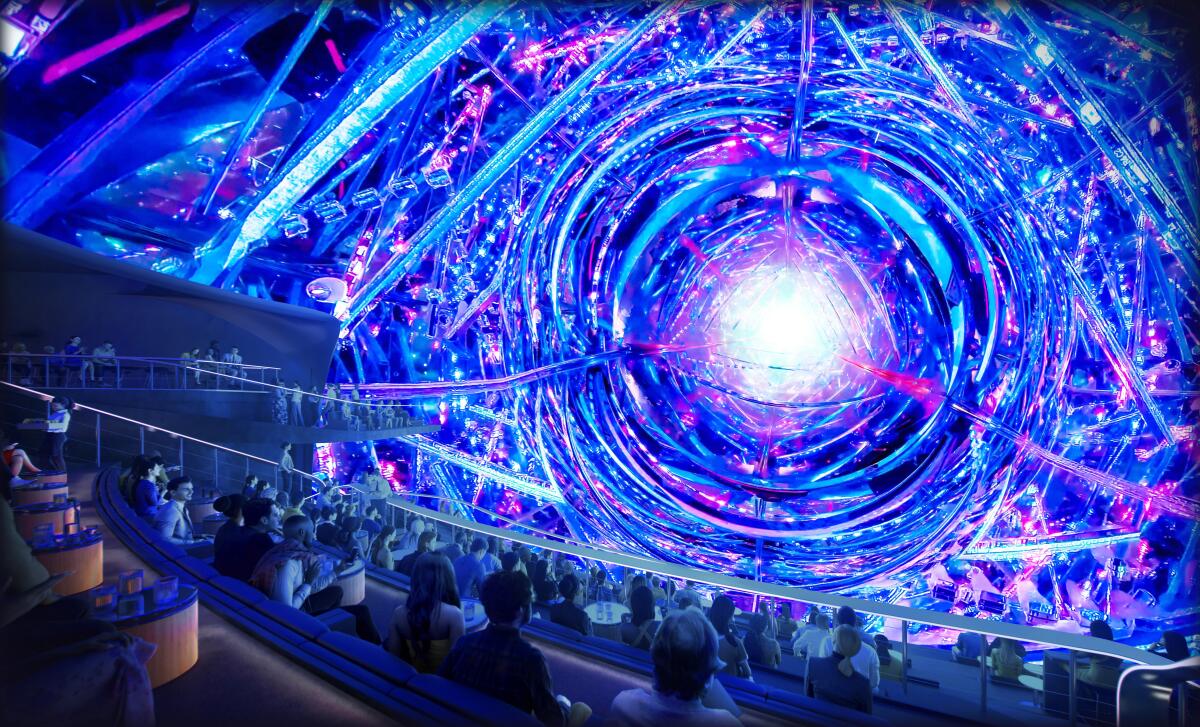
“The idea was building that cathedral of light and color,” he says. “We went up to test at the [full-scale] Cosm dome in Utah, and it totally blew my mind. I was crying watching my piece because this format didn’t exist when I started making my art, but it’s the perfect format for what I’m doing and this idea of having that shared reality with people.
“The example I give is like on the McCartney tour, when he plays ‘Hey Jude,’ you can be anywhere in the world, and you can look at 10 people or 20 people, and everybody’s feeling the exact same thing. They’re singing ‘na-na-na’s’ together, and their hearts are in it.”
Cosm venues strive to audibly re-create this sort of communal experience — the company uses spatial audio, which Holmes describes as “having cellos that spin all around the room. The drums are in front of you and the voice is whispering on the side.”
Chris Vogler, a developmental executive, screenwriter and author, saw Holmes’ piece at the Hollywood launch party last week (a preview of the experience coming to L.A. next spring). Vogler experienced it on a virtual reality headset, which mimics the effect of being in the dome by removing the edges of the frame from the viewer’s peripheral vision.
“Yayoi Kusama: Infinity Mirrors” opens Sataurday at the Broad museum in downtown L.A., but The Times got an early look at the exhibition on Monday and Tuesday.
Vogler said that while looking at the moving kaleidoscopes through the headset, his mind wandered. He found himself pondering what he was seeing, exactly. Were these images solely composed from the landscapes? Was he observing people walking around in front of him? “My brain was active, trying to figure this out.” Then, Vogler says he felt a shift, and “after about three minutes, I dropped all that. And it was like my mind turned a corner. And it was as if a slot opened up within this virtual space that I felt I could go through and in that window or slot was infinitely more.
“I think what was happening is that the overwhelmingness of the light and sound, got past the brain’s defenses, and opened up the doors of perception that Aldous Huxley talked about. I think it really happened in that short little time, so they’ve got hold of something pretty potent here. If it can do that without drugs, that’s pretty cool.”
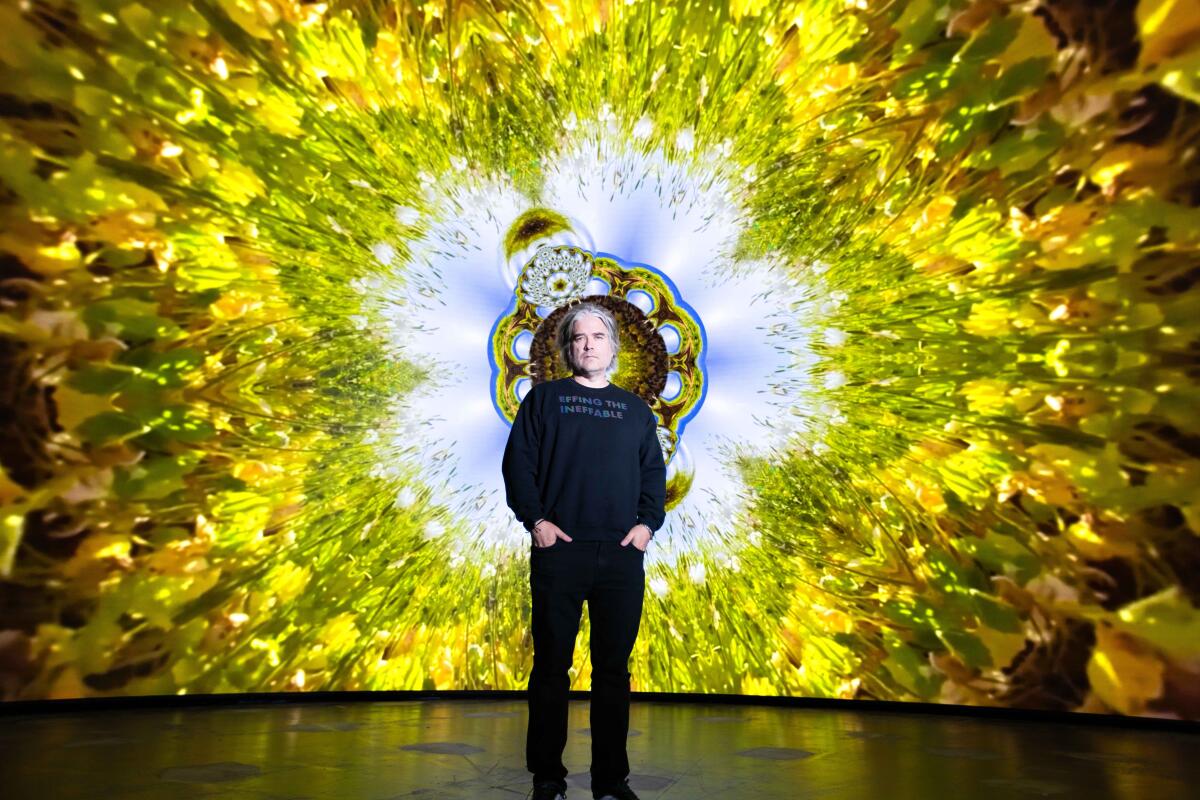
Vogler likened the experience to Jean Houston and Robert Masters’ altered states of consciousness induction device — acronym ASCID — which, according to the Encyclopedia of World Problems and Human Potential, induced a trance-like state by placing a person, who is supported physically and blindfolded, on a swing. “So I think what Chris has done,” Vogler continued. “Is he’s created an altered state of consciousness induction device. And, I think it worked on me.”
For this project, Holmes drew inspiration from a range of artists including Yayoi Kusama, James Turrell and Dan Flavin. Thomas Wilfred’s Clavilux and Laserium laser light shows also informed what became “The Journey Within,” which charts a hero’s journey in 32 minutes.
John Bucher, a mythologist, writer and head of the Joseph Campbell Foundation, spoke with Holmes while he developed the piece, which takes the viewer through the hero’s journey.
The two-and-a-half-hour SoFi Stadium concert, featuring a generous helping of Beatles songs, was McCartney’s first area show since 2019.
“We’ve just come out of this massive shift in society and culture, where all the information we could ever want in our lives is now in this little box we put in our pockets,” says Bucher. “What Chris has created, it’s antithetical to what we experience on a phone. This is meant to be a metaphor in some ways for the universe and perhaps even consciousness itself, which is what the hero’s journey and what all of mythology calls us to: to look at what is beyond us.”
In the last few years, immersive, experiential art installations have exploded in the cultural zeitgeist. But last month Now Lighthouse Immersive Inc., the company behind the “Immersive Van Gogh” and the “Immersive Frida Kahlo” experience, which occupied the former Amoeba Music building on Sunset Boulevard, filed for Chapter 15 bankruptcy.
And in May, Walt Disney Co. announced it was shutting down its own extravagant immersive experience: Walt Disney World’s Star Wars: Galactic Starcruiser, a two-night hotel stay that doubles as a live-in theme park and live-action role-playing game. It closes Sept. 30.
Lighthouse Immersive Inc., the Toronto-based company that brought “Immersive Van Gogh” to L.A., filed for Chapter 15 bankruptcy last week.
Cosm argues that its technological prowess sets it apart from other immersive experiences. “There’s a little bit of a challenge in the marketplace right now, where the word ‘immersive’ is thrown around quite a bit. And we’re trying to really redefine what it means and a lot of that is powered by technology. But if we do our job right, the technology fades away, and people just have an incredible experience.”
Cosm also counters that it offers something that Now Lighthouse Immersive Inc. and the Galactic Starcruiser did not: Variety of programming.
Cosm President and Chief Executive Jeb Terry, a former NFL pro, tells The Times that Cosm venues will operate almost like a television, with the channel constantly changing. For example, the venue may schedule Holmes’s piece for a Saturday night, and a football game on Sunday morning.
That’s made possible by Cosm’s unique software. L.A.’s Griffith Observatory already uses Cosm’s Digistar software for its Samuel Oschin Planetarium, which opened in 2006. It was one of the first major facilities in the U.S. to use Cosm’s computer graphics firm Evans & Sutherland’s all-dome digital laser projection system. In 2022, Evans & Sutherland installed a more technologically advanced Digistar 7 system for Smithsonian’s National Air and Space Museum’s (NASM) new planetarium theater.
The La Jolla Playhouse’s Wow Festival illustrates the ways in which theater and play continue to converge, most spectacularly in the world premiere of “La Lucha,” an immersive theater standout.
The company plans to expand its reach this way, in addition to increasing its venue space. “We’re the biggest planetarium company in the world. So now we’re gonna leverage our core software,” Terry says. The company has already partnered with the UFC and the NBA too, he notes.
During a visit to the scaled-down demo dome at Cosm’s Playa Vista office, Terry programmed a sports experience. Watching clips from the basketball game was not unlike occupying one of Jack Nicholson’s courtside seats. It’s tough not to flinch when a bead of LeBron James’ sweat appears to be flying in one’s direction.
Cosm — a name blending cosmos and colosseums — “is a nod to our history and heritage of great scientists and planetariums and engineers,” Terry says. The company’s progression towards entertainment, he adds, comes at a time when people seem to be craving more connectivity. “People just want an experience, they want to be with each other. They want to enjoy things. They want to go out and have that human connectivity. And that’s why we’re built this way.”
More to Read
The biggest entertainment stories
Get our big stories about Hollywood, film, television, music, arts, culture and more right in your inbox as soon as they publish.
You may occasionally receive promotional content from the Los Angeles Times.
